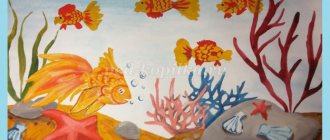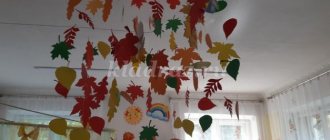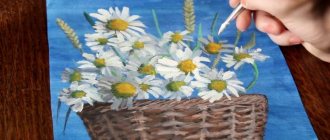Goal: development of independence, active skills of joint activities of children in the classroom. Training sessions: Strengthen the ability to draw strokes with pokes in a certain order, learn to paste ready-made shapes (circle) in a certain order, focusing on a sample. Developmental objectives: to develop children's sensory abilities - to recognize and distinguish between red, blue and yellow colors. Speech tasks: encourage the use in active speech of words denoting objects (sea, fish) and signs of objects (red, blue). Educational tasks: to develop independence and activity when choosing the color of the created image of a fish, type of activity; cultivate accuracy when choosing visual materials. Materials: “Sea” manual, a blue or light blue piece of fabric measuring 1x1 m “with seaweed” in red and yellow. Yellow and red paper fish attached to the front of the fabric. White fish “swimming” among the “algae”. Red and yellow paint (gouache), glue, red and yellow ready-made shapes for applique (circles), glue brushes, napkins, pokes, fish holders. Preliminary work. Exercise children in drawing with a brush and paints in the classroom; development of the ability to recognize and name red, blue and yellow colors; round dance game with the manual “Sea”.
Progress of the lesson:
1. Introductory part. Educator: Guys, look what we have. This is a blue, blue sea. In one distant country there is an amazing blue, blue sea. And two fish live in it - red and yellow. Do you see them? What color are they? When was the sea rough? (Swings the fabric faster) - that’s how it was worried - the fish were splashing around in the blue water. Like this. Sometimes our fish swam to the very bottom of the sea. Quickly and quickly raise your arms up and immediately lower them smoothly (3-4 times). Let's see what's there at the bottom of the sea. Who saw what? Educator: That's right, the fish there are white. What color are our fish? Red and yellow, and soon they became sad. Look how sad they have become. Sad fish? Do you know why? Because they had no friends - other red and yellow fish. Do you want to help them? Then sit down on your chairs, and I will tell you how you can do it. Finger game:
The fish swam, the fish swam, waved its tail, waved its tail, feed it quickly - it will be more fun to swim!
Educator: To help our fish, we need to make the white fish colored - red and yellow. You can color the fish with paints or with colored paper. Who wants to do what?
2. Main part:
(With the help of the teacher, children are seated at two tables)
Educator: Guys, please choose what color fish you will make - red or yellow? Look how I decorated my fish. I glued yellow circles between these stripes. Show with your finger where you will glue.
(The kids get to work, the teacher watches how the children hold the brush, spread glue on the finished forms, and glue them onto the finished bases)
Educator: Guys, look how I will decorate my fish. I want to decorate a yellow fish, so I take which fish? (Yellow). Now please choose paint colors for your fish.
(While the children are working, the teacher carries out individual work: he completes the drawing of the eye, shows how you can play with her - how she swims, how she opens her mouth, wags her tail)
3. Final part:
The teacher, with the help of the children, attaches the fish to the blanket with clothespins: red fish are near the red fish (these are her friends), yellow fish are near the yellow one. At the same time, children are asked questions.
Conversation on issues. — What color is your fish? - Which fish did she make friends with - red or yellow? — How did you paint the fish? - Did you like what you did? Educator: now our fish have many friends, they are happy. They play again, have fun and laugh. Let's see how they do it?
We are small guys, small, remote, we stood together around the sea, we raised the sea with the fish, and walked in a circle. We go, we go, we go in circles, and we squat down!
Author: Gabibullaeva Firoza Pashaevna, teacher of MBDOU DSKV No. 10 “Squirrel”
The article is published in the author's edition
Preview:
Lesson summary for children of the first junior group: “Fish swim in an aquarium.”
1. Exercise children in the technique of working with gouache; practice holding the brush correctly (without straining your muscles or squeezing your fingers), learn how to put paint on a brush, carefully dip all the bristles into a jar of paint, remove excess paint on the edge of the jar with a light touch of the bristles, learn to paint using an unconventional technique. 2. Develop aesthetic perception; draw children's attention to the beauty of surrounding objects and natural objects, develop interest in artistic activities. 3. Cultivate love for the living.
Equipment and materials: toys, fish in an aquarium, a painted aquarium, a dish with paint, wet wipes, paints, a brush.
Progress of the lesson: - Guys, who do you see on my palm? (Fish). Who has aquarium fish at home? Look at the fish, its head and body together form one whole. The body of the fish has an oval shape. And the tail looks like a triangle. What color is our fish? What other colors are fish? Now look carefully, I will show you how we will draw a fish. Place your palm in a plate with paint, place your palm on the center of our aquarium and press well. Then wipe your hand with a napkin. We take a brush, dip it in black paint and draw an eye and mouth for the fish. Wipe off excess paint from the brush on the edge of the jar. Dip your finger in green paint and draw algae. Draw a wavy line without lifting your finger, press firmly so that the finger mark is bright. Wipe your hand with a napkin.
PHYSICAL ACTIVITY MINUTE: Fishes swim in the water. It’s fun for the fish to play. Then they will shrink, they will unclench, and then they will bury themselves in the sand. Now we sit down and start drawing. Don’t forget that we first dip our palm in paint, draw the body of the fish, then draw algae, an eye and a mouth. (The children do the work.) Once you have finished drawing the fish, you can draw another friend for it. What beautiful fish you got.
Progress of the lesson
Introductory part (surprise moment)
(audio file with a baby crying is turned on)
The girl Masha is part of .
She's crying. The teacher draws the children's attention to Masha. Encouraging them to say hello to her. Masha: - Today the cat Vaska ate my favorite fish . And I felt very sad without her.
Educator: - Guys, let's help Masha. Let's draw a fish so that it doesn't feel sad. fish did you have ?
Educator: What color?
The teacher places images of aquarium fish , including goldfish, one .
Educator: - That's right! They float in the water. They need water to live. Do you think the fish see us ?
Finger gymnastics " Fish " arr. N. V. Nishchevoy
The fish swims in the water , the fish have fun playing .
(With their palms folded together, children depict how a fish )
Fish , fish , mischief, (They shake a finger)
We want to catch you. (Slowly bring palms )
The fish arched its back , (Again they depict how the fish )
I took a bread crumb. (Make grasping movements with both hands)
The fish waved its tail , the fish swam away again (hide the hands)
.
Educator: - This is not an ordinary fish house, but a glass one. Let's repeat the name of the house - aquarium (children repeat in chorus and several answers individually)
.
Only it's empty. Let us draw a fish so that she doesn’t cry anymore.
The teacher shows the children what he will do. his palm in the paint and applies it to the template, after which an imprint remains on the sheet. After this, he asks the children to repeat the same actions themselves.
Or he paints the child’s palm himself if this causes difficulty for the child. In this case, the fingers can be spread out or pressed, both options are possible.
Then children dip their finger in the paint and use dotted movements to make paint marks on the bottom of the aquarium . After each change of paint, wipe your palms with napkins .
Educator: - While the fish , we will play.
The fish swim in the water (make smooth (wavy)
hand movements);
Fishes have fun playing . They will clench and unclench (The hands clench into fists and unclench with their fingers outstretched)
;
Then they will bury themselves in the sand (Imitation of hands digging in the sand)
.
Final part (Reflection)
Summary of the GCD for drawing with palms in the second junior group “Autumn Tree” Drawing with palms is a very interesting and spectacular process, both for children and adults. When we draw with our palms, the work comes into play.
Summary of a lesson on applique from natural material “Goldfish” for children of the first junior group Educational area “Artistic and aesthetic development” Goal. Development of children's creative potential. Formation of ability to work.
Notes for a drawing lesson “Track for an engine” in the first junior group LESSONS FOR A DRAWING CLASSES “WAY FOR AN ENGINE” IN THE FIRST YOUNGER GROUP Notes for a drawing lesson for the first younger group. Notes for a drawing lesson “Matryoshka” in the first junior group SUMMARY OF DRAWING CLASSES “MATROSHKA” IN THE FIRST YOUNGER GROUP, Materials and equipment: Matryoshka toy, prepared. Summary of a drawing lesson in the first junior group “Puddles” Purpose: to train children in drawing a continuous rounded line, using a brush to paint the surface without going beyond the boundaries. Objectives: Educational:. Summary of a drawing lesson in the first junior group “Amanita” Goal: to expand and clarify children’s knowledge about mushrooms. Introduction to the technique of drawing with cotton swabs. Objectives: Educational: continue.
Summary of the drawing lesson “Fishes swim in the water!”
Maya Yuricheva
Summary of the drawing lesson “Fishes swim in the water!”
GOAL: To introduce children of primary preschool age to the visual arts
activities in drawing classes .
1. Continue teaching children to depict simple objects in their surroundings.
2. Continue to introduce children to non-traditional ways of depicting (finger printing technique)
.
3. Develop the plot and game concept.
4. Cultivate interest in the world around us.
5. Maintain an emotional attitude towards the results of your work. EQUIPMENT:
- silhouettes of fish cut out of thick paper,
-drawing of an aquarium on a sheet of A3 paper,
- toy FISH , -basins, -fishing rods.
- learning finger gymnastics,
- looking at fish in an aquarium,
- conversation about fish ,
— individual work with children on finger printing techniques.
On the topic: methodological developments, presentations and notes
"Fishes swim in an aquarium." Summary of an art lesson using non-traditional drawing techniques.
Summary of a lesson in the middle group using non-traditional drawing techniques.
Objectives:-1. Exercise children in the technique of working with gouache; Practice holding the brush correctly (without straining your muscles or squeezing your fingers); Learn to carefully put paint on the brush, dip it.
The abstract was compiled taking into account the principle of the Federal State Educational Standard for Education - individualization of education.
Formation of cognitive and speech activity of preschoolers through integrated activities in kindergarten.
Summary of a drawing lesson for the second junior group “Fish swim in an aquarium” PROGRAM CONTENT: EDUCATIONAL OBJECTIVES: · Teach children how to draw fish in.
OOD on artistic and aesthetic development 2 fish swim in the aquarium.”
Source




